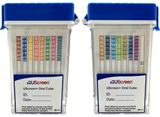SCHOOLS UTILIZE SALIVA ALCOHOL TESTS TO COMBAT UNDERAGE DRINKING
Educational facilities often use an alcohol-testing device to monitor the behavior of students on campus. High school applications include sporting events, dances, and off-campus school activities. Private schools often use random alcohol testing to monitor day to day behavior of students.
Why are schools resorting to alcohol testing?
Alcohol use is one of the most significant concerns for American youth, as it is the most widely used drug. The most recent Monitoring the Future Study shows that 30% of all high school seniors, 17% of 10th graders and 8% of 8th graders used alcohol regularly. The rate of alcohol consumption increases with increasing age according to the 2017 National Survey on Drug Use and Health from less than 1% at age 12 to 16% at age 16, and 46% at age 20.
These high numbers cannot be ignored. Student alcohol testing can contribute to the drug education prevention efforts of schools addressing alcohol use.
The effectiveness of alcohol testing
Alcohol testing is an effective deterrent to alcohol use among underage students in school. It is also a primary way to identify individuals who need help. Students subject to testing have a built-in reason to say no when offered alcohol, even when faced with extreme peer pressure. Students who participate in extracurricular activities such as sports, cheerleading, and band, are natural role models to other students, and alcohol testing helps ensure that they set a proper example.
Reasons for alcohol testing may include any all or some the following:
- To establish a safer learning environment.
- To reduce at-school accidents.
- To improve the health and well being of students.
- To eliminate crime, including theft and violence, at school.
- To reduce the number of dropouts.
- To decrease absenteeism.
- To improve students’ academic performance.
- To enhance your school’s public image.
How alcohol testing works
As alcohol is consumed, it enters the bloodstream rapidly. It is then carried throughout the body where it interacts with various systems and leaves behind traces in the form of metabolites. These indicators of alcohol consumption are detectable in an individual’s saliva for about 12 to 24 hours after alcohol has been ingested. The indicators make saliva alcohol testing a highly accurate way to check for very recent alcohol use.
In scientific research studies, Ethyl Glucuronide (EtG) was found to be a direct metabolite of alcohol (ethanol). The EtG test is known as the “80-hour test” for detecting any amount of consumed ethyl alcohol.
The benefits of EtG tests
- They detects recent usage more accurately and for a more extended period than standard testing
- No false positives
- No EtG found in non-drinkers
- Ideal for zero tolerance and abstinence situations
- A reliable indicator of alcohol consumption
- Beneficial for monitoring in alcohol treatment programs
AmericanDrugTest.com assists schools, student programs, and parents with screening youth for the use of Alcohol. Our test kits are quick, easy, and confidential. Our results come back fast and are accurate.
We offer a wide range of testing services, including saliva alcohol testing. Our certified personnel can walk you through every step of the process, providing complete confidentiality and fast, reliable results.
Recent Posts
-
Why Adulterant Panels Matter: Enhancing Integrity in Drug Test Cups and Dip Cards
Detailed Overview of Urine Adulterants Introduction: The Importance of Adulterant Panels in Drug Tes …Jun 4th 2025 -
UScreen® Oral Plus 16-Panel Saliva Flip-Top Cube: Unmatched Coverage, Accuracy, and Ease of Use
Employers and organizations continue to shift toward oral fluid drug testing for its sp …May 28th 2025 -
Understanding Fentanyl and Norfentanyl Testing: Key Information
Fentanyl and Norfentanyl are closely related compounds associated with opioids. With numerous testin …Apr 29th 2024



